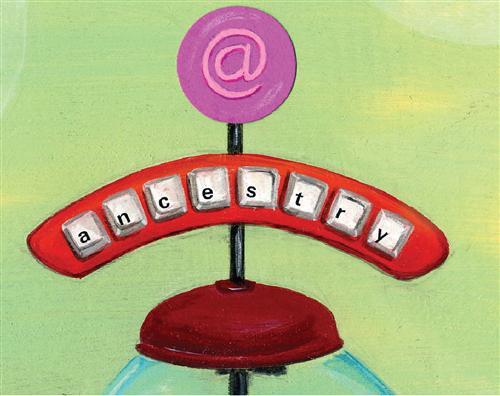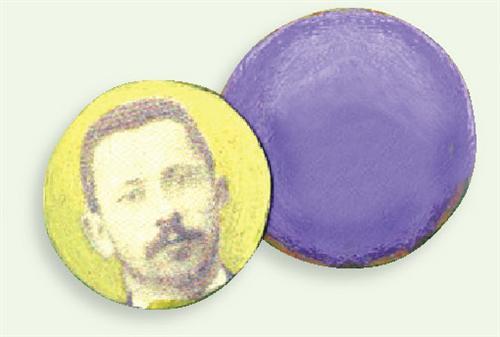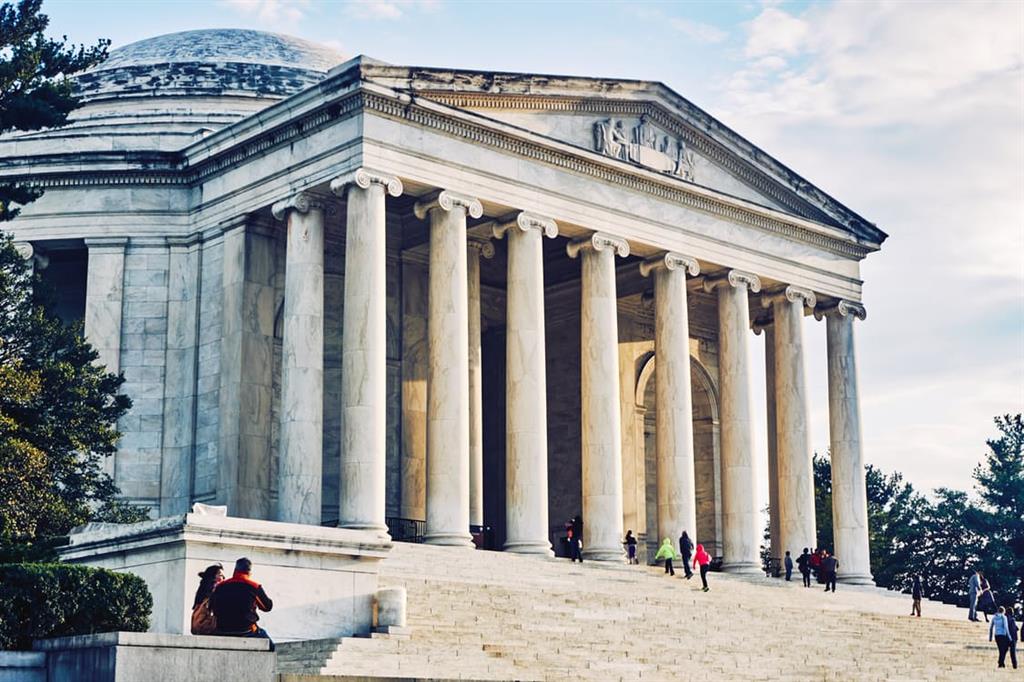
Accessible Archives
<www.accessible.com>
County histories usually include biographies of local residents, and Accessible Archives makes 92 rare county histories from the Mid-Atlantic states accessible online. Search for a name anywhere in county histories from Maryland, New Jersey, New York and Pennsylvania, and you could discover priceless details about your ancestor’s personality, exploits, education, religious affiliation, military service and careers. For example, a history of Schoharie County, NY, argues that contrary to his reputation in some camps as “a loud-mouthed Irishman” and “a cool, intrepid murderer,” my relative Timothy Murphy was actually a kindhearted man and a Revolutionary War patriot and hero.
In addition to county histories, Accessible Archives includes a collection of magazines and newspapers. Its 18th-and 19th-century Pennsylvania newspapers and 19th-century African-American newspapers list marriages, obituaries and biographical data. Civil War-era newspapers give firsthand accounts of the conflict. And Godey’s Lady’s Book provides insight into women’s lives during the 1800s.
You can subscribe to Accessible Archives for $9.95 for 30 days or $49.95 a year, or get access to just the county histories for $14.95 a year — far less than you’d pay for a reprint of even one of these books.
American Civil War Research Database
<www.civilwardata.com>
“The Civil War was the defining moment in our nation’s history,” says webmaster Dick Dobbins. “Ninety percent of Union soldiers and 80 percent of Confederate soldiers were literate, and they left diaries and many other records.” Drawing on state rosters, pension indexes, regimental histories, Rolls of Honor, photographs and other sources, Dobbins and his crew created the American Civil War Research Database. The database continues to grow, and Dobbins invites you to submit information, pictures and documents to expand each soldier’s story.
The American Civil War Research Database is a great tool for identifying your soldier’s dates of service and unit — the information you need to request copies of his service and pension files from the National Archives and Records Administration <archives.gov>. For instance, the site shows my relative Charles Hall joined Company K of the 42nd Pennsylvania Infantry July 31, 1861, and died at the Battle of Antietam the next year. But Dobbins also wants to put each soldier’s service in a broader historical context, so his “casualty analysis” notes that Charles Hall was one of 151 soldiers in the regiment who were killed or mortally wounded. Another 88 died of disease or accidents.
An annual subscription costs $25, and a seven-day visitor’s pass to just the soldiers’ military information is $10. Although Ancestry.com’s version of the database, called the Civil War Research Database, is current as of May 2007 with more than 4 million records, this standalone version will continue to be updated much more often.
Footnote
<www.footnote.com>
It’s exciting to see an ambitious new genealogy site emerge. Just months after its initial launch, Footnote already has several large databases and is adding millions more new documents every month.
Although many of the databases are more historical than genealogical, there’s still a lot of useful content. A $7.95 monthly or $59.95 annual subscription gets you access to databases such as the Civil War pensions index; actual images of Confederate soldier service records from Alabama, Texas and Virginia; an index to selected New York naturalization records; and New England city directories. Alternatively, you can buy a single document image for $1.95.
The company made headlines earlier this year by reaching an agreement with the National Archives and Records Administration (NARA) <archives.gov> to digitize some of the archives’ record collections — an arrangement that has already resulted in the aforementioned pension index, plus Southern Claims Commission papers, which document Southerners’ claims for compensation for items used by the Union Army.
In another joint venture, Footnote is working with the Church of Jesus Christ of Latter-day Saints’ Family History Library 
Some Footnote databases, such as the Civil War pensions index, provide image transcriptions that are detailed enough for you to glean the key information without having to pay. Others — including the 100,000-page Pennsylvania Archives series — are free in their entirety.
Also free is a Footnote membership, which lets you attach comments to documents and maintain a gallery of your favorite Footnote images. Additionally, you can create a “story page” — for example, someone already annotated a document from the second Battle of Saratoga with a biography of my sharpshooter relative Timothy Murphy.
On the home page, you can search everything at once or browse through the databases. When browsing, both the description above and the search form below change to reflect the category, database title or state you select. Pick a group, such as Revolution: 1775-1815, and you can search the entire group. Scroll to the right and select a specific database, such as Revolutionary War Rolls or a state within that file, and the search form reflects your selection. Footnote has a flashy, futuristic look and a slick document viewer.
GenealogyBank
<www.genealogybank.com>
Another major new site, GenealogyBank, provides access to newspapers, obituaries, and historical documents and books. For $19.95 a month or $119.95 a year, you get:
• Historical Newspapers, 1690-1977: View actual images of more than 500,000 issues from 1,300-plus old US newspapers held by the American Antiquarian Society <www.americanantiquarian.org>. This is a tremendous tool for finding newspaper references to your ancestors in the 1700s and 1800s, even if you don’t know where they lived.
• America’s Obituaries, 1977 to Present: These 23.2 million obituaries come from more than 800 US newspapers. Most obituaries date from 1999 to today.
• Historical Books, 1801-1900: Search the full text of 11,000 books, pamphlets, genealogies, biographies, local histories, cards, charts and funeral sermons. The latter seem to dominate this unusual set, also from the American Antiquarian Society’s collection.
• Historical Documents, 1789-1980: The primary resources here are the American State Papers (1789 to 1838) and genealogical content from the US Serial Set (1817 to 1980). (But don’t subscribe just for these two resources: They’re also on the Library of Congress’ American Memory site).
GenealogyBank continually expands its collection, so keep an eye out for new additions. So far, the site’s major draw is the Historical Newspapers collection, which you also can access through the New England Historic Genealogical Society, the New York Genealogical & Biographical Society and the Godfrey Memorial Library — but not through Ancestry.com.
Genealogy Today
<www.genealogytoday.com>
Genealogists would probably find non-traditional sources such as criminal records and club memberships extremely useful — if they were more accessible. Family Tree Connection, the largest of several databases at Genealogy Today, aims to do just that. Its index covers high school and college yearbooks, city directories, fraternal organizations, church records and other sources. Many more documents published between 1830 and 1930 are in the pipeline. To get an idea of Family Tree Connection’s scope, go to the Genealogy Today home page and click on Library Catalog to search or browse.
Searching Family Tree Connection, I found a reference to a great-uncle’s funeral home record and a wanted poster for a James Pennington — a name passed down through several generations of my family. Though it’d be fun to add a black sheep to my family tree, apparently this outlaw wasn’t one of my James Penningtons.
Thousands of names are added to Family Tree Connection every week. Subscribe to the free Surname Tracker service, and you’ll be notified by e-mail whenever a name you’re researching turns up.
Genealogy Today’s name index is free, but you’ll need a $29.95 annual subscription to get complete references. Who knows? Maybe your ancestor will show up on a wanted poster.
Godfrey Memorial Library
<www.godfrey.org>
A private library in Connecticut focusing on genealogy and history, the Godfrey Memorial Library lets you register for a Godfrey Scholar library card no matter where you live. Benefits of an annual membership include access to several major online newspaper collections:
• Accessible Archives: You get that site’s historical newspapers, but not the county histories.
• Early American Newspapers: This is the same great collection of newspapers from the American Antiquarian Society dating back to 1690 and found on several other commercial sites.
• The London Times Digital Archive 1785-1985: Access 200 years of Great Britain’s premiere newspaper.
• Newsbank: The newspaper collection includes more than 1,400 US and foreign titles. You also get America’s Obituaries (same as on GenealogyBank) and the Chicago Tribune Historical Archive, which covers 1860 to 1984.
Another resource, Marquis Who’s Who, contains 1.3 million-plus biographies from 21 Who’s Who print titles.
Godfrey recently introduced a (somewhat confusing) tiered membership system: You get the aforementioned databases and assorted other resources with a $35 Red Scholar subscription. Add NewspaperArchive.com to the mix as a $65 Blue Scholar. Green Scholars get the Red resources plus World Vital Records for $80. Or pay $110 a year for the whole shebang.
National Genealogical Society
<www.ngsgenealogy.org>
While maintaining its focus on providing education, fostering scholarly standards and promoting access to genealogical records, the National Genealogical Society (NGS) has added several useful members-only databases to its Web site:
• Family Bibles: 94,000 names in family Bible records are linked to images of the original records.
• Marriage and death notices: Taken from the National Intelligencer newspaper, they date from 1800 to 1850.
• Member ancestry charts: NGS has indexed and digitized members’ ancestor charts submitted between the 1960s and 1995. Now covering a million names, the database is expected to reach 1.5 million by the end of this year.
In addition to these resources, a $55 yearly NGS membership includes subscriptions to NGS NewsMagazine and the NGS Quarterly, a journal that publishes thoroughly researched and documented family histories.
New England Historic Genealogical Society
You used to have to travel to Boston to use the New England Historic Genealogical Society’s (NEHGS) outstanding research library. Now a $75 annual membership gives you online access to many of the library’s key resources, including these popular databases:
• Massachusetts Vital Records: Birth, marriage and death records date back to Colonial times. Most of the 8.5 million entries from 1841 to 1910 link to images of the original records.
• New England Historical and Genealogical Register. Published since 1847, this journal contains research articles on New England families, especially in the Colonial period.
• The Search for Missing Friends: Irish Immigrant Advertisements Placed in The Boston Pilot 1831-1920: Check this database for your Irish immigrant ancestors, and you might learn their dates of immigration, their hometowns in Ireland and the names of family members. (Boston College’s similar free database, Information Wanted <infowanted.bc.edu>, is far less comprehensive.)
• Cemetery databases: The site’s gravestone transcriptions cover 1,650 cemeteries in New England, New York and eastern Canada.
• The Great Migration Begins: Immigrants to New England 1620-1633, Volumes I-III: These comprehensive profiles of passengers and their families cover the first big wave of New England immigrants.
• Early American Newspapers Series I, 1690-1876: This is the same excellent resource available through GenealogyBank, Godfrey Memorial Library and the New York Genealogical & Biographical Society.
You also get subscriptions to The New England Historical and Genealogical Register and New England Ancestors with your membership. NEHGS is currently revamping its site to make the databases more accessible, comprehensive, easier to navigate and of greater value to casual genealogists.
New York Genealogical & Biographical Society
<www.newyorkfamilyhistory.org>
Founded in 1869, the New York Genealogical & Biographical Society maintains one of the largest genealogical libraries in the United States. Its collection of 75,000 books, 30,000 manuscripts, 1,300 periodicals and 22,000 microforms focuses on New York state genealogy and local history, but also includes significant holdings for the New England states and New Jersey.
What if you can’t travel to the library in New York City? In order to make its holdings available to members everywhere, the society has created an online “eLibrary” to house digitized versions of its paper holdings. The first additions to the eLibrary (42 cemetery files and 44 religious files) were drawn from the society’s large collection of New York state cemetery and church record transcriptions.
Other key online resources include digital images of the society’s journal, The New York Genealogical and Biographical Record, from 1870 to 1960, and the journal’s annual indexes from 1961 to 2001. It also offers the Early American Newspapers collection from the American Antiquarian Society that’s available on various subscription Web sites.
A $60 annual membership includes subscriptions to The New York Genealogical and Biographical Record and The New York Researcher. Though it has a fraction of the society’s brick-and-mortar library, the eLibrary is a draw for potential members who can’t get to New York City.
World Vital Records
After launching World Vital Records with a modest subscription service in 2006, the site’s development team — led by Ancestry.com co-founder Paul Allen — is now aggressively ramping up World Vital Records’ content. The goal: Turn World Vital Records into a major genealogy player (its slogan: “building the No. 2 genealogy site,” after Ancestry.com). To that end, the company has been partnering with other genealogical organizations to expand the site’s offerings. Among those partners’ contributions:
• Quintin Publications: World Vital Records is digitizing and gradually adding 10,000 books and articles from this publisher of family histories, county histories and vital records.
• Everton Publishers: Search for ancestors’ names in 200 issues of Everton’s Genealogical Helper, a magazine filled with readers’ queries, and 150,000 pedigree and family group sheets submitted by readers of the Helper. Titles from the Everton Library Collection of family histories, local histories and record compilations are also being added.
• SmallTownPapers: 160 newspapers dating back to the 1800s are free to search and view.
• Godfrey Memorial Library: World Vital Records will be scanning and indexing books, articles and church records from the Connecticut genealogical library.
More for the Money
We couldn’t cover every pay-to-play genealogy site in detail, so peruse this list for additional online subscription options:
• HistoryKat
<www.historykat.com>: Instead of trying to compete head-to-head with the giant genealogy sites, Matthew Helm’s History Kat focuses on resources unavailable elsewhere online, such as War of 1812 military bounty-land warrants, postmaster and letter-carrier lists, and selected state and territorial censuses. Note that most record images aren’t indexed, and a high-speed Internet connection is recommended.
Price: $24.95 a year
• Legacy
<www.legacy.com>: Genealogists focus mostly on older records, but recent obituaries often provide family information going back decades, and help you locate living relatives. Legacy has 6.5 million obituaries back to February 2001, and adds about 200,000 new obituaries every month. You can view obituaries and related “Guest Books” on Legacy for free for at least 30 days.
Price: $2.95 per archived obituary, first 24 words are free
• ObitsArchive.com
<www.obitsarchive.com>: Search obituaries from 859 US newspapers going back as far as 1980 for free — you can query on the name of the obituary’s subject and any other words in the text, such as a place of residence, occupation and relatives’ names.
Price: $2.95 per article or $19.95 a month for TOO articles
• ObituaryRegistry.com
<www.obituaryregistry.com>: Another site for recent obits, ObituaryRegistry.com’s collection totals no million, with 6,500 new names added per day. The obituaries are supplemented by data from the Social Security Death Index.
Price: genealogy rate of $24.95 for three months
• OneGreatFamily
<www.onegreatfamily.com>: Akin to the free RootsWeb WorldConnect Project <worldconnect.rootsweb.com> and Ancestry World Tree <Ancestry.com >, OneGreatFamily takes the pedigree-database concept a step further by merging duplicate ancestor entries and automatically searching the full database for matches to your entries.






